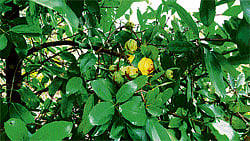
In recent times, many indigenous fruits such as the deep purpled jamun and wild berries are being marketed in many melas and horticultural exhibitions. Anitha Pailoor feels it is important to conserve these fruits from the wild, not only for the variety they bring to the fruit basket, but also for their medicinal value.
“The fruit costs Rs 180 per kilo. It is a medicinal fruit, not an ordinary one!” Ramesh, a fruit vendor in the City market, is not concerned about the sale of juicy, dark coloured jamuns (syzigium cumunii) piled on his push cart.
The cart, with a couple of other red, yellow and green coloured wild fruits, is a window to the diverse wild fruits of the region.
The profuse fruiting and simultaneous ripening of the jamun is indicative of the onset of the rainy season and commencement of agricultural operations.
Jamun is considered wild but it is also cultivated. The fruit is rich in vitamin C. Its leaf and bark are also used in the preparation of medicine. Jamun seed powder is said to control diabetes.
Kokum (garcinia indica) and amla are other wild berries that are also cultivated. Along with these two prominent berries, there are many other wild fruits which are as good a source of nutrients as traditional fruits. Any person who has spent his childhood in the countryside is bound to have vivid memories of plucking assorted fruits from thorny bushes, tall trees and delicate vines in the woods.
“The berries hanging from high branches taught us tree climbing. Such trees do not exist anymore. The impact can be seen in wild animals crossing the threshold into farm lands,” says Venkatakrishna Sharma who has been trying to protect existing wild species in and around his farm in Muliya, Dakshina Kannada.
He has found a rare bannerale plant (syzigium hemisphericum) near his farm. Bats and monkeys feed on this fruit. Sharma feels that jackfruit and wild mangoes which grow naturally can also be added to the list of wild fruits.
He feels that rapid urbanisation, neglect of wild varieties in favour of hybrids and timber value of old trees are some of the reasons that pushed these varieties behind the screen.
Positive approach
In recent times, we have been witnessing several efforts to bring neglected fruits to the foreground. Be it in the form of a jackfruit mela or a wild mango exhibition, other wild berries also get a special mention.
Concentrated fruit syrup, squash, dried rind, jam, pickle and dry fruits are some of the common value-additions that are displayed.
The possibility of domestication of wild edible plants which have commercial value has also been explored. Way back in 1999, when dried kokum rind was priced at Rs 35 per kilo, Dattatreya Hegde Bairimane in Sirsi decided to plant them on two acres along with another wild berry, uppage (garcinia cambogia).
Another farmer in Sirsi, Mangalamurthi Dixit has grown kokum in his betta land (patches of natural forest linked to arecanut plantations). The labour problem that has hit agriculture has had a negative impact on this crop also.
Kokum fruits are ready in summer while uppage fruits ripen in the monsoon season, from June to August. Both the fruits are valued more for their dried rind. Kokum pulp is used in preparing jam. Dry rinds are also used as substitutes to tamarind in certain native dishes.
Till now, processing and value-addition of wild species are either done at the individual level or in home-based industries. Manorama Joshi, a farmer entrepreneur feels that successful local usage of these fruits could be an answer to the nutritional problems in rural areas, particularly among children and women. The fruits also have economic potential.
“Wild berries were our cookies during school days. Some of the fruits tend to colour our tongue. Unlike chocolates, each fruit tastes differently,” says Manorama who has observed that the word ‘wild’ has an immediate impact on consumers, whether in cities or towns. Manorama has been using wild food in the kitchen and also for medicinal purposes.
Distinct varieties
Each geographical area has unique wild varieties. Though wild fruits are found throughout the year, they are found prominently in summer.
A weed that grows in black cotton soil bears the fruit kaki hannu (solanum nigrum). The fruit, which tastes similar to tomato, is valued for its laxative properties. Gudde hannu (physalis minima) is a common weed that grows on the bunds in irrigated fields in North Karnataka.
Petlekai (grewia nervosa), gamatekai (solena amplexicaulis) hulimajjigehannu (tali minor), challe hannu (cordia dichotoma), khare hannu (canthium parviflorum), koule kayi (carissa carandas) and sampige hannu (flacourtia montana) are some other fruits that are popular. These fruits are naturally hardy and require less intensive care.
Shivakumar, a civil engineer in Madikeri, has been gathering information on wild species from the last two years.
He has managed to gather references on about 108 berries that are grown in Kodagu, while he has been able to explore 45 of them so far.
He feels that some of the species are specific to certain geographical conditions. Along with jamun, some other berries like karmanji and sarali are sold in the local market in Madikeri. Some of these fruits dominate over regularly available fruits in terms of price and demand.
He also poses serious questions about the sustainability of the resource base. Some of the plants and vines are cut for agricultural use. It is clear that once the demand increases, fruits are harvested by lopping branches and even cutting small trees. This practice can only increase pressure on resources.
